ACTIVITY
By resolution (02-211/1 dated 04.02.1997) adopted by the Council of the Institute of Earthquake Engineering and Engineering Seismology (IZIIS) and support given by the Ministry of Foreign Affairs, the Ministry of Education and Science and the Government of the Republic of Macedonia (1220-469/2 dated 28.01.1997), a centre was established within IZIIS under the title European Centre for Vulnerability of Industrial and Lifeline Systems (ECILS) in March 1997 (21-891/1 dated 06.03.1997).
By the resolution adopted by the permanent correspondents of the countries-members of the EUR-OPA Major Hazard Agreement (23-24.05.1997, in Potenza, Italy), ECILS was included in the network of specialized Euro-Mediterranean centres under the Council of Europe’s Open Partial Agreement (OPA) for prevention and protection against disasters and assistance in conditions of severe natural and technological hazards.
The mandate of ECILS complies with the scientific and development policy of IZIIS, but also with the strategic goals of the EUR-OPA Major Hazard Agreement. Since its establishment to date, ECILS has realized numerous activities and projects in the domain of urban risk and vulnerability, natural and man-made hazards, raising of preparedness and response capacities as well as numerous consulting and professional missions and activities.
ECILS is a non-profit organization with a seat at IZIIS.
Projects:
Urban historic centers are invaluable cultural and economic assets but are often at risk from earthquakes due to the vulnerability of their older masonry structures. These buildings, typically constructed without modern seismic codes, are common across Europe and beyond. Renovations, often superficial or intrusive, can further compromise their structural integrity, making seismic risk assessment essential for their preservation and safety.
This project addresses the need for a harmonized approach to evaluating the seismic vulnerability of historic urban centers, with a focus on Skopje, the capital of North Macedonia. Drawing on international research and post-earthquake damage data, it adapts existing methodologies to reflect the specific characteristics of Skopje’s historic buildings.
The project considers a vulnerability index method that assesses risk through a simplified scoring system based on structural and architectural parameters. These parameters (P1 to P14) are customized to capture the unique features of Skopje’s historic urban center, allowing for a more accurate and localized evaluation of seismic vulnerability.
By harmonizing global best practices with local needs, this project aims to support decision-makers in prioritizing interventions and preserving cultural heritage. It emphasizes the importance of integrating seismic resilience into urban planning, ensuring historic centers remain both safe and sustainable for future generations.
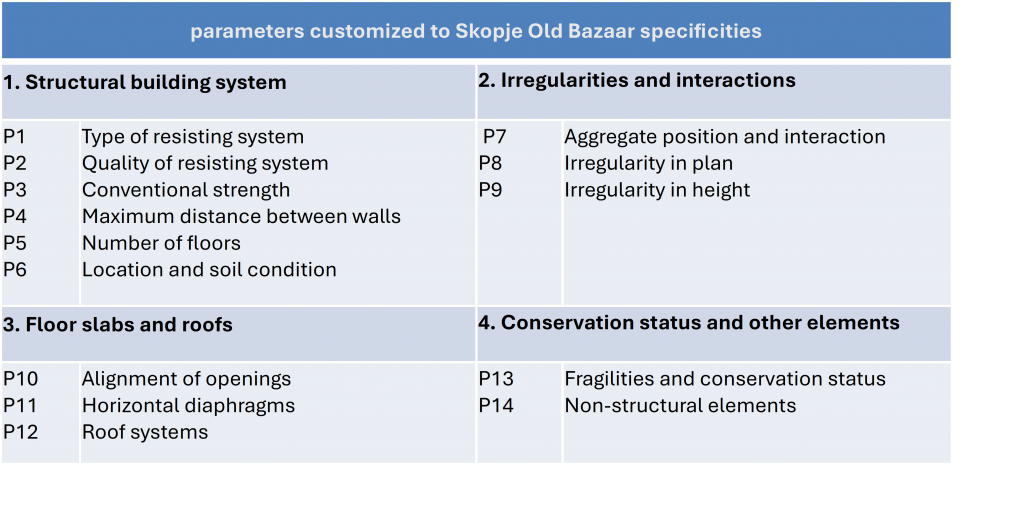
The Old Bazaar in Skopje, a cultural and historical treasure dating back to the 12th century, has long been a hub of trade and commerce in the Balkans. Recognized as cultural heritage of particular importance in 2008, the area has been undergoing revitalization since 2011 to enhance its appeal as a tourist destination. However, the 2016 Skopje earthquake (M=5.1) exposed significant seismic vulnerabilities in many of its buildings, underscoring the urgent need for pre-earthquake vulnerability assessments as part of the revitalization process.
This project aimed to conduct the first-ever rapid visual screening (RVS) of 30 representative buildings in the Old Bazaar, providing a preliminary assessment of seismic risk. The methodology, developed in collaboration with ECPFE (European Centre on Prevention and Forecasting of Earthquakes) in Greece, involved both indoor and outdoor visual inspections and photographic documentation. A manual for the screening process was created, and permission for building inspections was provided from the Office for Protection of Cultural Heritage in June 2021. However, the COVID-19 pandemic delayed on-site inspections, which remain pending.
Key achievements during the reporting period include the development of a first-level data form for RVS, calibrated using data from the 2016 earthquake, and a comprehensive manual for its application. These tools represent a significant step toward systematically assessing and mitigating seismic risks in Skopje’s Old Bazaar. Future plans involve completing the inspections, selecting a representative building for further analysis, and validating the proposed method to ensure the resilience and preservation of this historic site.
By combining local efforts with international expertise, this project highlights the importance of integrating seismic safety into the protection and revitalization of cultural heritage sites.


This joint initiative between ECILS (North Macedonia) and ECPFE (Greece) focuses on advancing methodologies for the seismic assessment and retrofitting of historic masonry structures—key elements of cultural heritage that are highly vulnerable to earthquakes. These efforts address a common European challenge in preserving public-use buildings while ensuring seismic resilience.
The activities within the first phase of the project, realized in 2022, focused on conducting the first-ever rapid visual screening (RVS) of 31 buildings along Salih Asim Street in the Old Bazaar, marking a milestone in seismic risk evaluation for North Macedonia. The screening applied a calibrated vulnerability index method using a First-Level Data Record Form and Manual developed under previous EUR-OPA grants. The methodology involved indoor and outdoor visual inspections and photography, and resulted in seismic vulnerability scoring for each building, determining their vulnerability ratings and prioritizing them for further assessment.
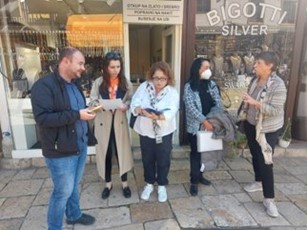

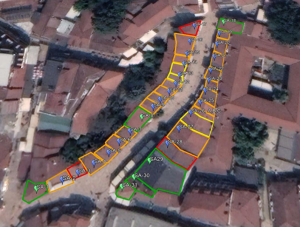
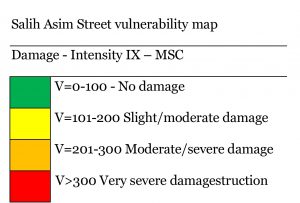
Following the first phase project’ outcomes, the 2023 activities progressed to second-level assessments. A key milestone was a joint meeting in Nafplio, Greece, where ECILS and ECPFE teams shared methodologies and conducted comparative analyses of selected buildings. The ECILS second-level method, focusing on structural bearing and deformation capacity, was applied to one building, demonstrating its detailed evaluation process.
Technical visits to Bitola and Ohrid, North Macedonia, further enriched collaboration, as teams identified similarities in building characteristics and discussed potential case studies for next joint project.
Key achievements include the validation of methodologies through international comparison, creation of seismic vulnerability maps, and strengthening networks between experts. This partnership exemplifies the value of cross-border cooperation in addressing seismic risks to cultural heritage, paving the way for standardized and effective solutions.

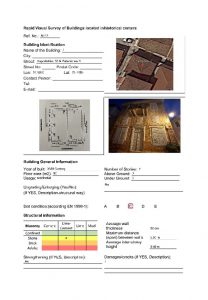


This project, coordinated by the ECPFE Centre,  aimed to strengthen collaboration and knowledge-sharing among experts, academics, and decision-makers in seismic assessment and retrofitting of historic masonry structures. These structures, widely used and highly vulnerable to earthquakes, present a common engineering and risk mitigation challenge across Europe. The initiative focused on introducing Greece’s newly developed Code for the Assessment and Structural Interventions of Masonry Structures (KADET), which provides criteria for assessing structural capacity, potential interventions, and redesign after retrofitting.
aimed to strengthen collaboration and knowledge-sharing among experts, academics, and decision-makers in seismic assessment and retrofitting of historic masonry structures. These structures, widely used and highly vulnerable to earthquakes, present a common engineering and risk mitigation challenge across Europe. The initiative focused on introducing Greece’s newly developed Code for the Assessment and Structural Interventions of Masonry Structures (KADET), which provides criteria for assessing structural capacity, potential interventions, and redesign after retrofitting.
A key component of the project was a workshop held in Athens on September 13, 2023, where leading experts involved in KADET’s development presented the Code’s methodology, scope, basic principles and other chapters in detail. This event provided participants with a comprehensive understanding of the Code, which aligns with Eurocodes (notably EC 8.3) but offers a more detailed approach for assessing and retrofitting historic masonry structures. ECILS representatives also shared North Macedonia’s experiences in seismic retrofitting through presentations at the Athens workshop, highlighting notable projects and challenges in their country.
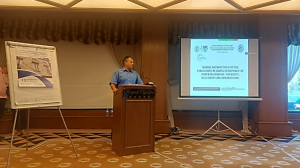

A follow-up workshop was organized in Skopje on 23 May2024 to present the KADET to the experts andprofessionals in North Macedonia, among which were representatives from the Ministry of culture, Directorate for protection of cultural heritage, Civil and Architectural faculties from Skopje and colleagues from the Conservation 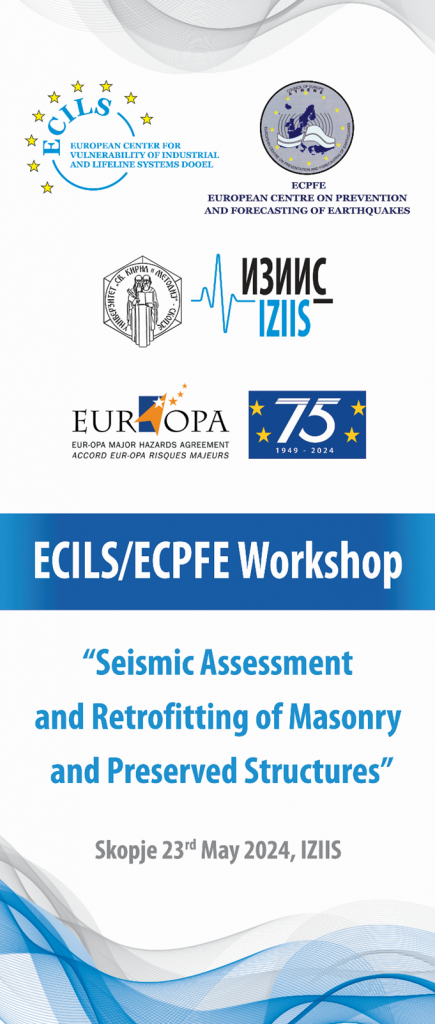 Centres across the country. It was a great opportunity to follow the presentations in considerable detail directly from the team who prepared the Code; their presentations initiate great interest, as evidenced by the discussion and dialogue that followed. The event provided an excellent platform for networking, leaving everyone inspired and looking forward to future opportunities for continued dialogue and collaboration.
Centres across the country. It was a great opportunity to follow the presentations in considerable detail directly from the team who prepared the Code; their presentations initiate great interest, as evidenced by the discussion and dialogue that followed. The event provided an excellent platform for networking, leaving everyone inspired and looking forward to future opportunities for continued dialogue and collaboration.
The project’s main achievements included fostering international collaboration and advancing knowledge on seismic retrofitting methodologies. Both workshops were especially valuable in identifying shared challenges and solutions, inspiring the possibility of developing a similar seismic retrofitting code in North Macedonia with guidance from Greek experts.
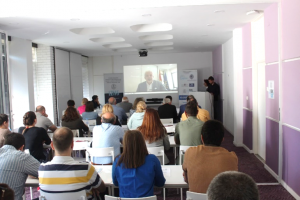
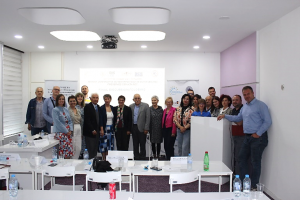
The idea for this project on Seismic behaviour of characteristic types of Byzantine churches in Balkan region, which is to be implemented in two phases (2024 and 2025), arrows from the joint technical visit of representatives from the European Centers ECPFE and ECILS to Bitola and Ohrid within the framework of Activity 2023, as a follow up. It is coordinated by the ECPFE, while ECILS, ECRM, Croatian Center of Earthquake engineering and Albanian Cultural Heritage without Borders office are partners. Its main goal is to record the vulnerability, seismic behavior, pathology and the retrofitting measures undertaken in characteristic types of Byzantine Churches such as architectural data (construction period, methodology), the bearing system type, local constructional and geomorphological characteristics, seismic hazard of the area, geometry etc. In the second project phase it is planned to categorize the examined churches and to compare the differences or similarities between the countries involved in this project, and to finally propose a pre-earthquake rapid visual inspection procedure and the restoration strategy.
During the joint meeting between ECILS and ECPFE representatives in Ohrid in September 2024 technical visits to six remarkable churches were organized and preliminary data on the specificities of churches in the Ohrid region were collected, following by discussion on similarities and specificities, present state, authenticity and extent of intervention, as well as exchanging ideas for the following topics within the project.
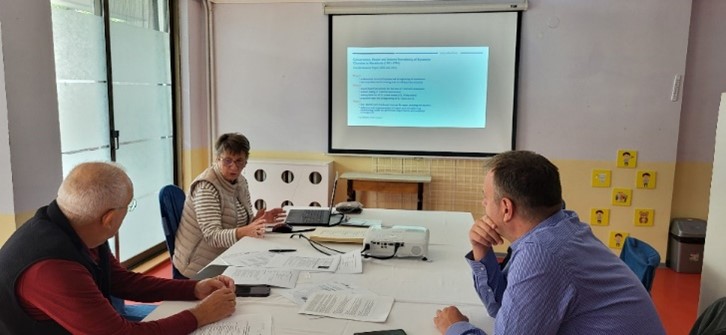



The first phase of Activity was finalized by the workshop in Ioannina on 19 October 2024, were the participants from Greece, North Macedonia, Armenia, Albania and Croatia presented the specific characteristics of Byzantine churches in their territory. The presentations were very valuable and useful, especially because they highlighted the common challenges that churches face and how they can be overcome. ECILS’ presentation included aspects on typology, structural systems, pathology and retrofitting in general but also data on 50 Byzantine churches on the territory of our country.



MANAGER

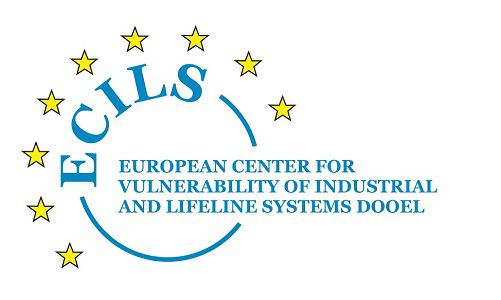
CONTACT
European Centre for Vulnerability of Industrial and Lifeline Systems (ECILS)
Address:
Todor Aleksandrov 165,
P.O. Box 101
1000 Skopje
R. N. Macedonia
Email: ecils@iziis.ukim.edu.mk
Tel: +389-2-3107-701
Fax: +389-2-3112-163
